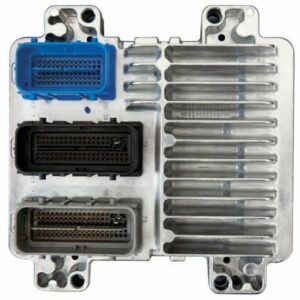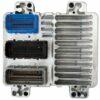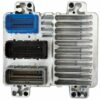Restore Peak Performance and Reliability to Your Vehicle
Is your Cadillac, Chevy, or GMC plagued by frustrating issues like a persistent check engine light, random stalling, or a complete no-start condition? These are classic signs of a failing Engine Control Module (ECM), the critical computer that manages your vehicle’s engine performance, fuel economy, and emissions. Don’t let a faulty module keep you sidelined. This direct-replacement 2009 XLR Engine Module is the definitive solution, arriving at your door fully programmed with the latest GM software for your specific vehicle.
As a technician with over two decades of experience, I’ve seen firsthand how a failing ECM can mimic a dozen other problems, leading to wasted time and money on incorrect diagnoses. This module eliminates the guesswork. We handle the complex programming for you; simply provide your vehicle’s VIN during checkout, and we’ll flash the unit before it ships. This means no expensive trips to the dealership and no special scan tools required for programming. It’s a true plug-and-play fix designed to get you back on the road with confidence.
Case Study: A Tricky Diagnosis
A 2009 Cadillac STS was towed into my bay with an intermittent no-start and a dashboard that lit up like a Christmas tree. The owner had already replaced the battery and alternator. My initial scan pulled a flurry of communication codes, chief among them a U0100 (Lost Communication with ECM). While this can point to wiring issues, my experience told me to check the ECM’s power and ground circuits first—they were solid. The tell-tale sign was that the module would occasionally drop offline entirely. We swapped in a pre-programmed ECM just like this one, and the vehicle fired up instantly and ran perfectly. This part saved the customer hundreds in diagnostic time and provided a lasting repair.
Common Signs of a Failing Engine Computer
If your vehicle is exhibiting any of the following symptoms, a faulty ECM could be the culprit. A proper diagnosis is always recommended, but these are strong indicators:
- ✔ Check Engine Light is on with codes like P0601 (Internal Control Module Memory Check Sum Error) or other P06xx codes.
- ✔ Vehicle will not start or is very difficult to start.
- ✔ Stalling or sputtering, especially under load or when warm.
- ✔ Noticeable decrease in fuel economy.
- ✔ Poor engine performance, hesitation, or misfires.
- ✔ Automatic transmission shifting issues.
- ✔ Loss of communication with other modules (U-codes).
A Straightforward Guide to Installation
Installing your new 2009 XLR Engine Module is a simple process that most DIYers can complete with basic hand tools. Because we program it for you, the most difficult step is already done!
- Safety First: Disconnect the negative terminal from your vehicle’s battery to prevent any electrical shorts.
- Locate the ECM: On most compatible vehicles, the ECM is found in the engine bay, often on the firewall, inner fender, or near the air cleaner box. Refer to your vehicle’s service manual for the exact location.
- Disconnect and Remove: Carefully unplug the electrical connectors from the old module. There are typically release tabs that need to be pressed. Once disconnected, unbolt the module from its mounting bracket and remove it from the vehicle.
- Install the New Module: Bolt the new, pre-programmed ECM into place. Reconnect the electrical harnesses, ensuring they click securely into position.
- Reconnect Power: Reattach the negative battery terminal and tighten it securely.
- Perform Security Relearn (If Needed): Some vehicles may require a simple security relearn procedure. This typically involves turning the key to the ‘ON’ position for 10-15 minutes, then off, and repeating two more times before starting the engine. Your vehicle’s manual will have specific instructions.
Verified Vehicle Compatibility
This ECM is a direct replacement for a wide range of General Motors vehicles. Please verify your model and engine options below. This module is interchangeable with service numbers: 12636659, 12639300, 1263605, 12628993, 12628911, 12625453, 12622175, 12630464, and 12678512.
- Buick DTS: 2009-2011
- Buick Lucerne: 2009-2011 (4.6L)
- Cadillac CTS: 2009 (6.2L)
- Cadillac SRX: 2009 (4.6L)
- Cadillac STS: 2009 (4.4L, 4.6L), 2010 (4.6L)
- Cadillac XLR: 2009 (with ID 12636659 or 12625453)
- Chevrolet Colorado: 2009, 2010-2012 (2.9L, 3.7L)
- Chevrolet Corvette: 2009 (ZR1)
- Chevrolet Trailblazer: 2009 (6.0L)
- GMC Canyon: 2009, 2010-2012 (2.9L, 3.7L)
- GMC Envoy: 2009 (5.3L)
- Hummer H3: 2009, 2010 (3.7L)
- Saab 9-7X: 2009
Frequently Asked Questions About This ECM
Do I need to program this 2009 XLR Engine Module?
Do I need to program this 2009 XLR Engine Module?
No. We handle all the programming for you before we ship the part. We use your Vehicle Identification Number (VIN) to load the latest, most stable GM software for your specific vehicle, making it ready for installation right out of the box.
Where do I provide my VIN?
You can provide your 17-digit VIN in the notes section during the checkout process. Please double-check it for accuracy to ensure correct programming.
Is a security relearn procedure difficult?
Not at all. For most GM vehicles, it’s a simple key-cycle procedure that takes about 30 minutes and requires no special tools. This process syncs the new ECM with your vehicle’s anti-theft system.
My original part number isn’t 12678512, but it’s on the interchange list. Will this work?
Yes. GM often consolidates part numbers. If your module’s service number is on our interchange list (e.g., 12636659, 12625453, etc.), this ECM is the correct, updated replacement for your vehicle.
What happens if I don’t provide a VIN?
We cannot ship the module without a VIN, as the programming is essential for it to function in your vehicle. Our team will contact you to retrieve the VIN if it’s missing from your order, which may cause a delay in shipping.



